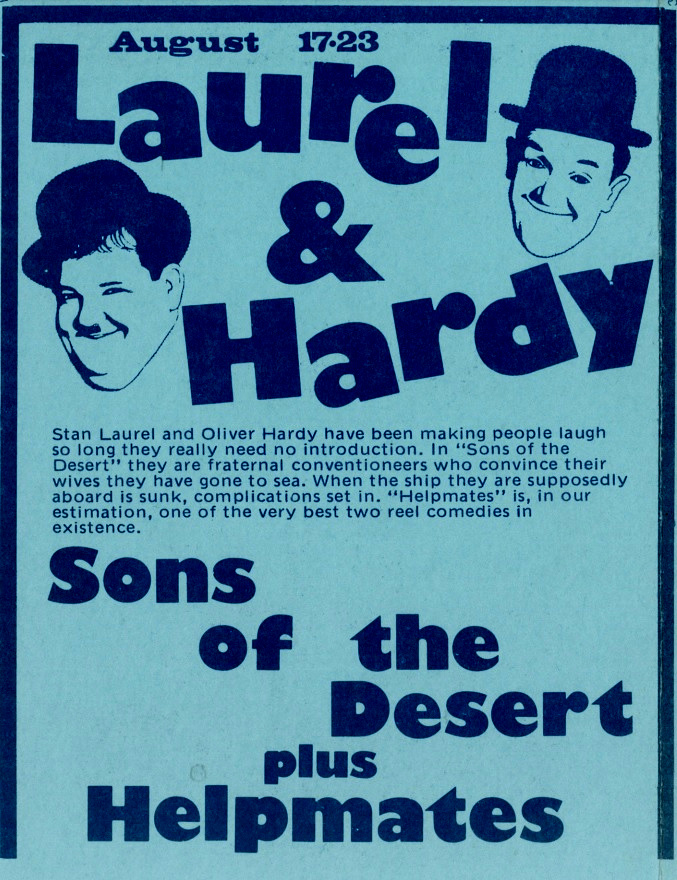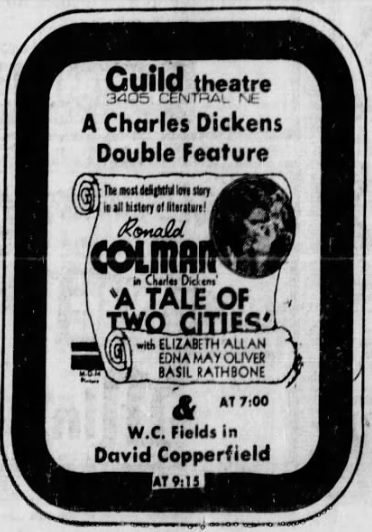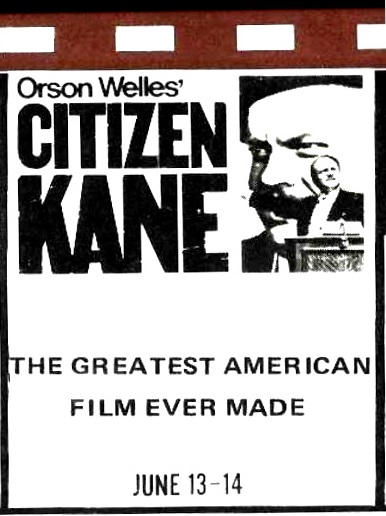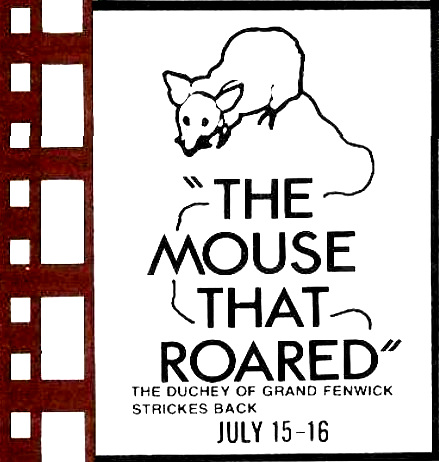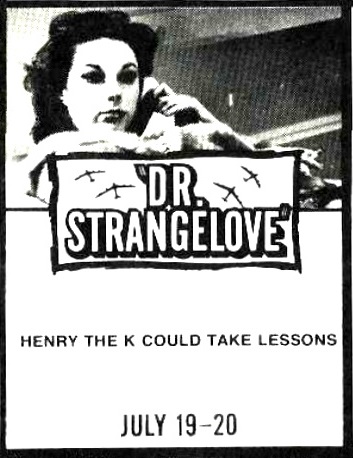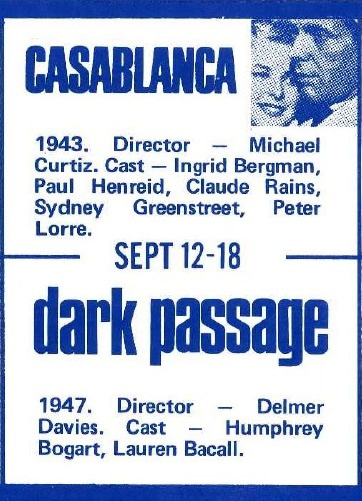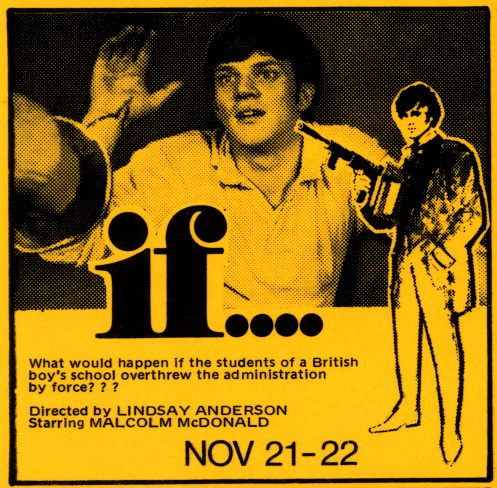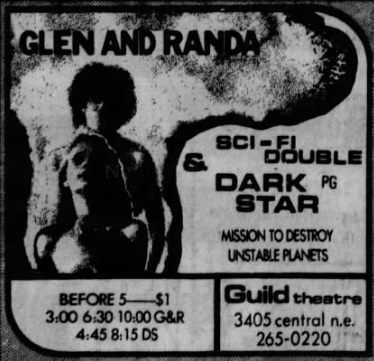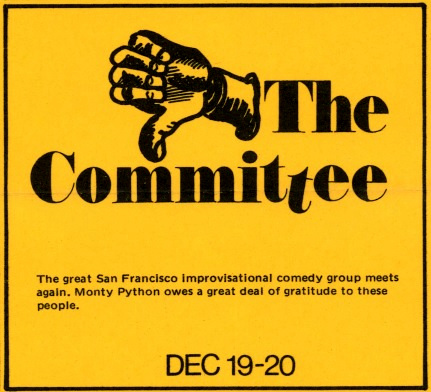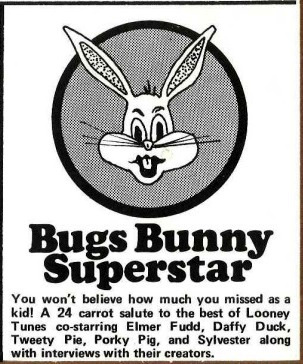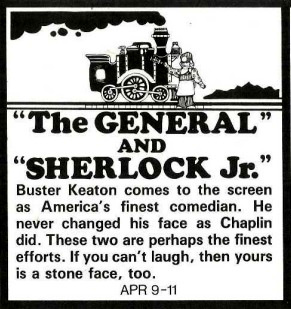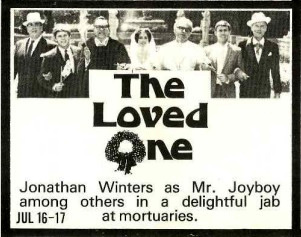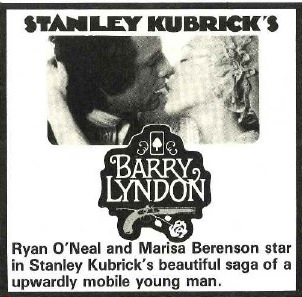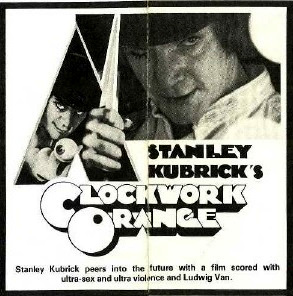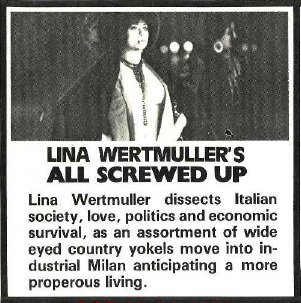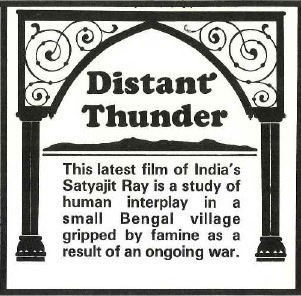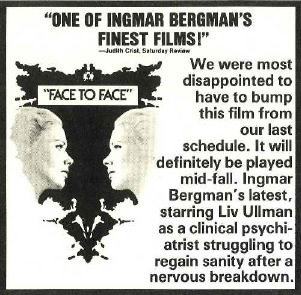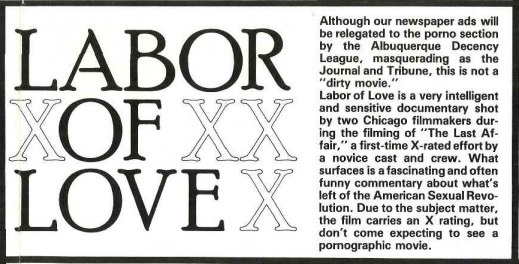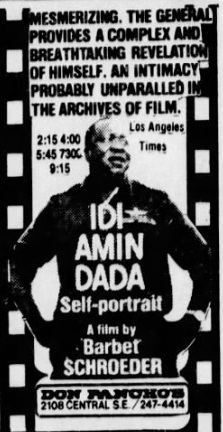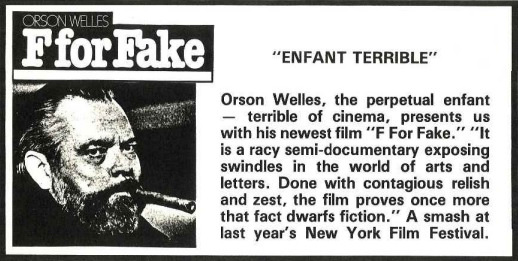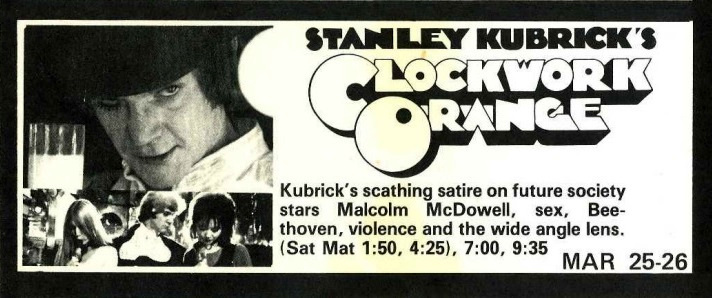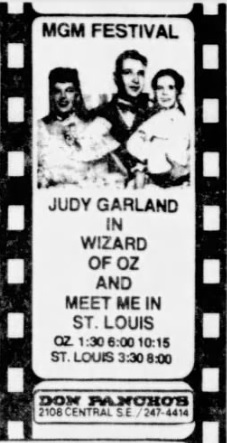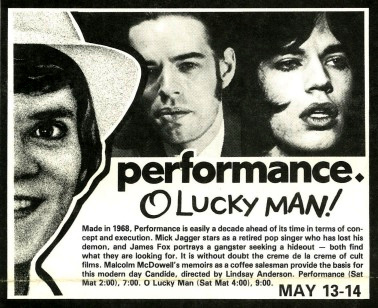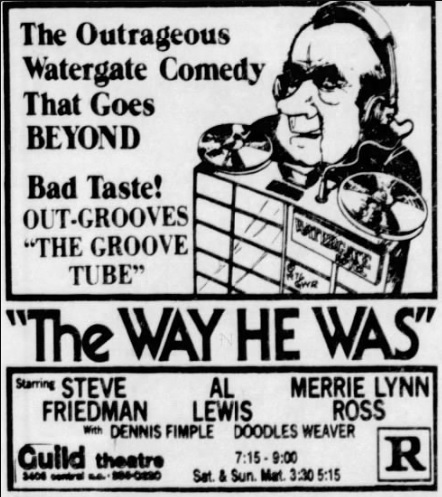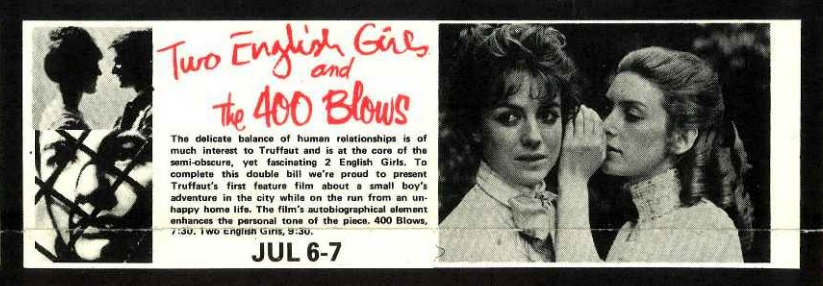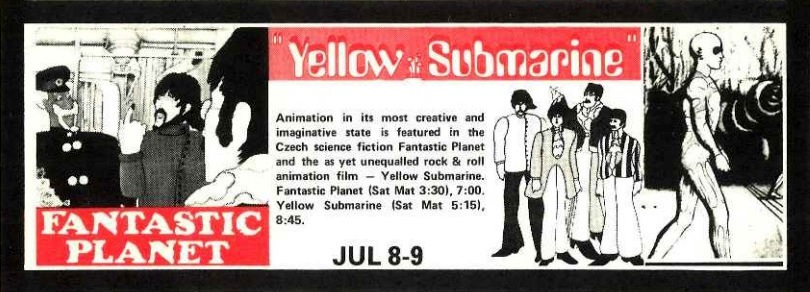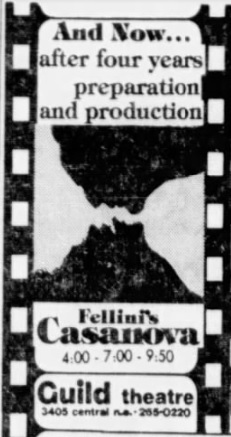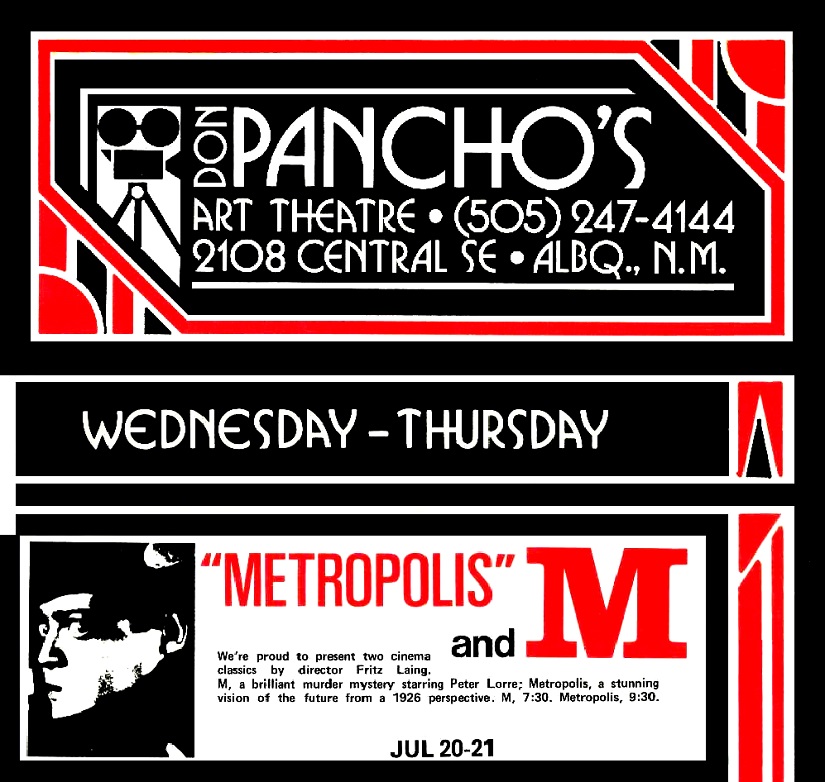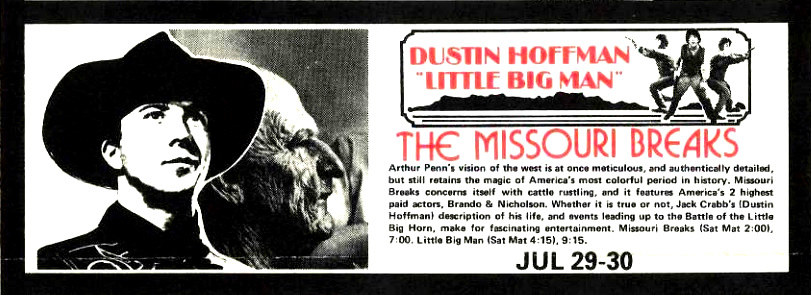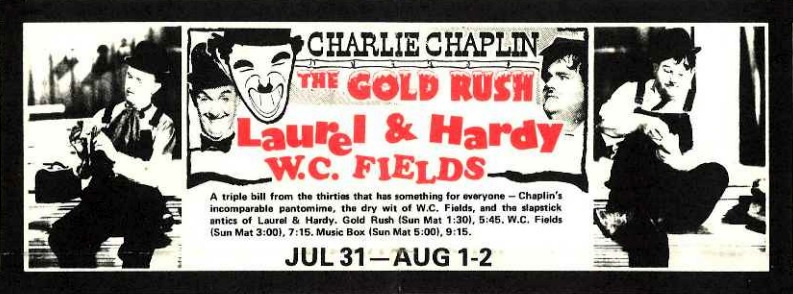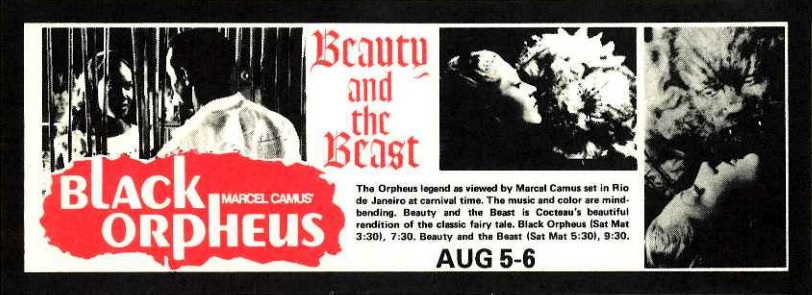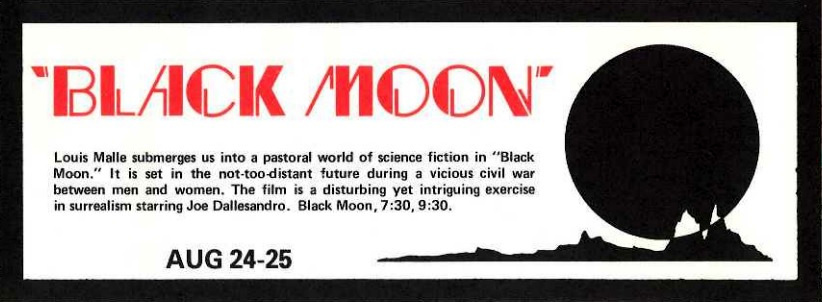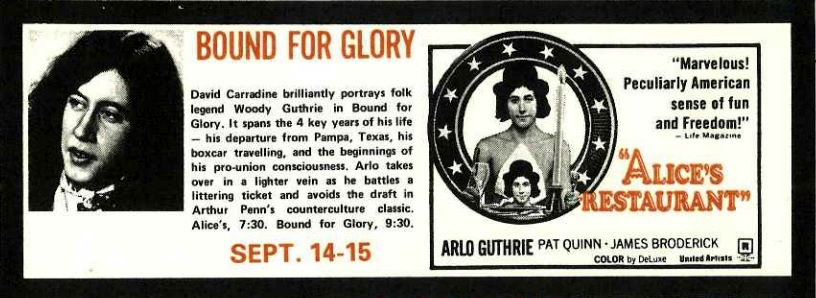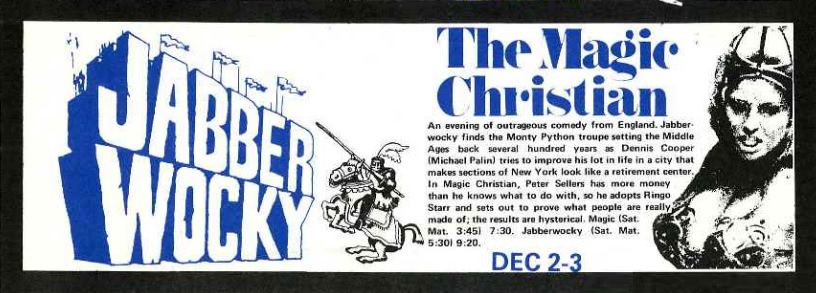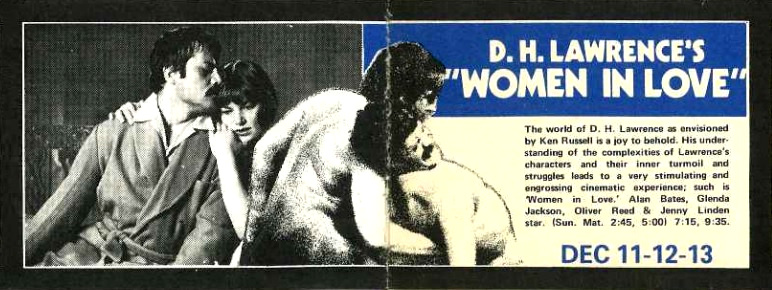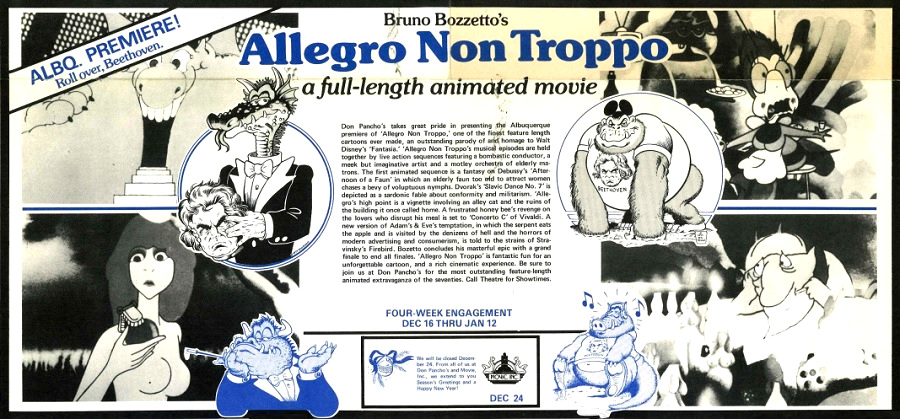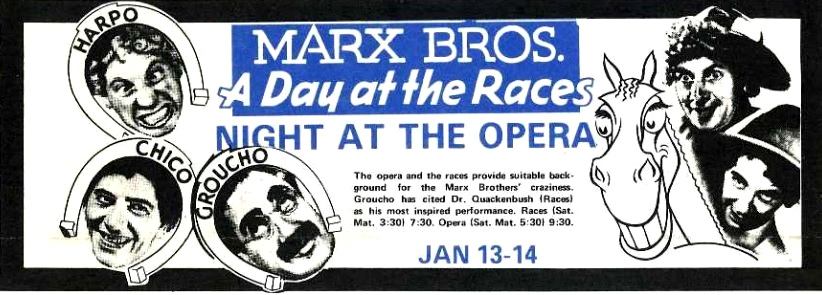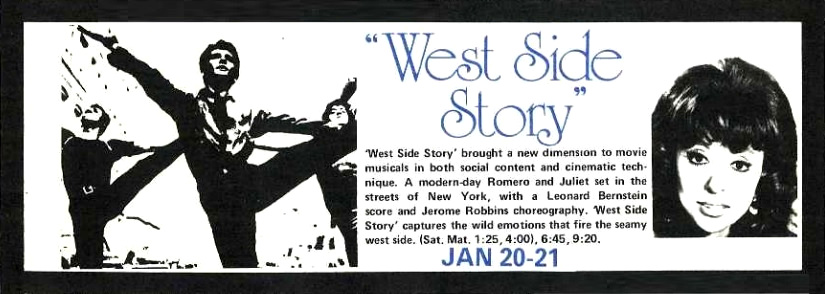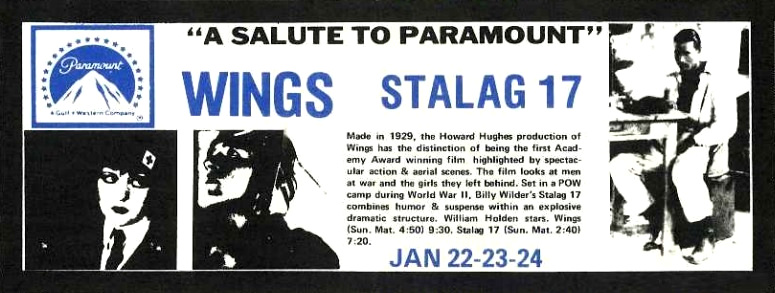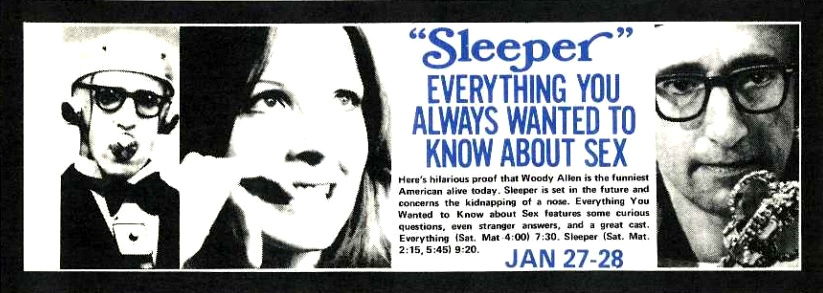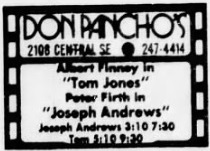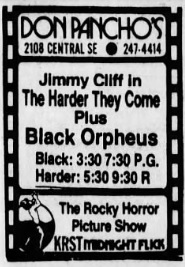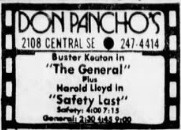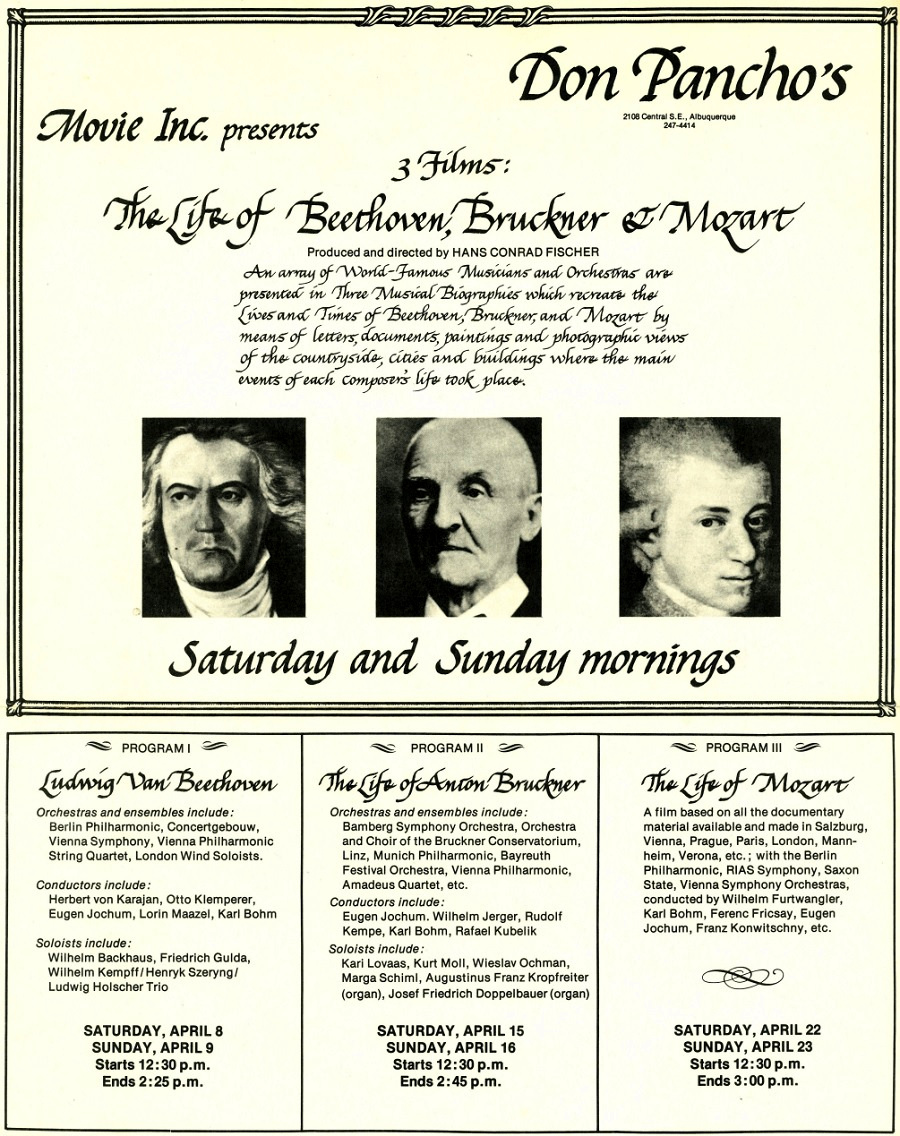You can skip this page.
This is probably not for you.
As of today, there is a grand total of one person who finds this interesting.
Perhaps a few hundred years from now, a historian will salivate over such picayune details.
When I research things that happened a few hundred years ago, these are the sorts of details that I crave,
but I never find them, anywhere, ever.
MEMORIES
(only because nobody else would ever record them):
(only because nobody else would ever record them):
• Don Pancho’s and The Guild used these dater strips.
I don’t remember the name of the company that produced them.
They were all shot with the Silent aperture, lopped to MovieTone,
but could be projected at the most extreme crops.
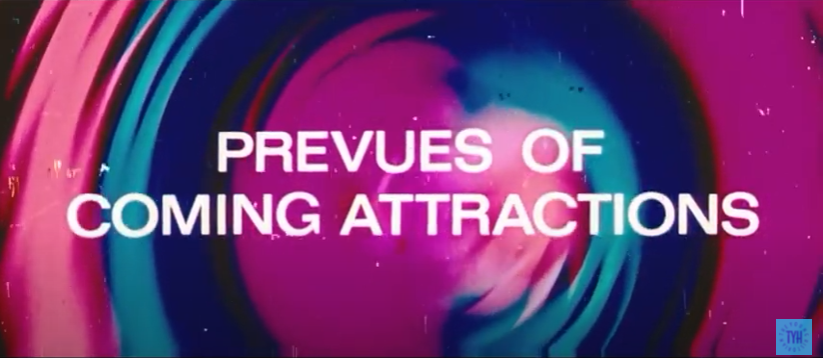

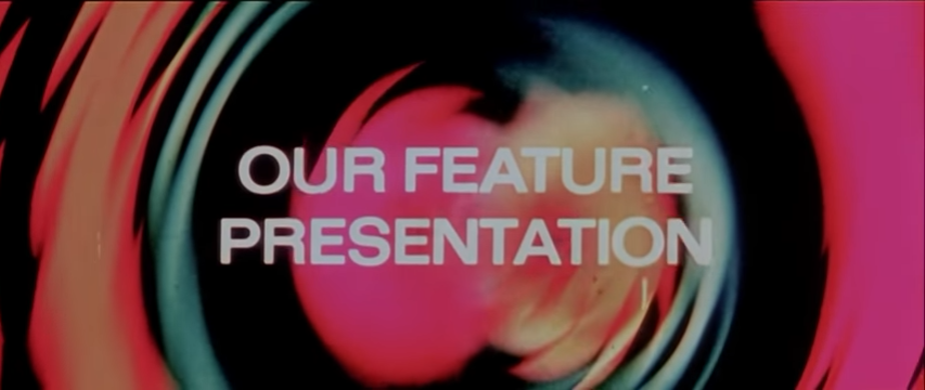
Ah. Here’s one that’s opened up to about the Academy 1:1.375 setting, more or less:
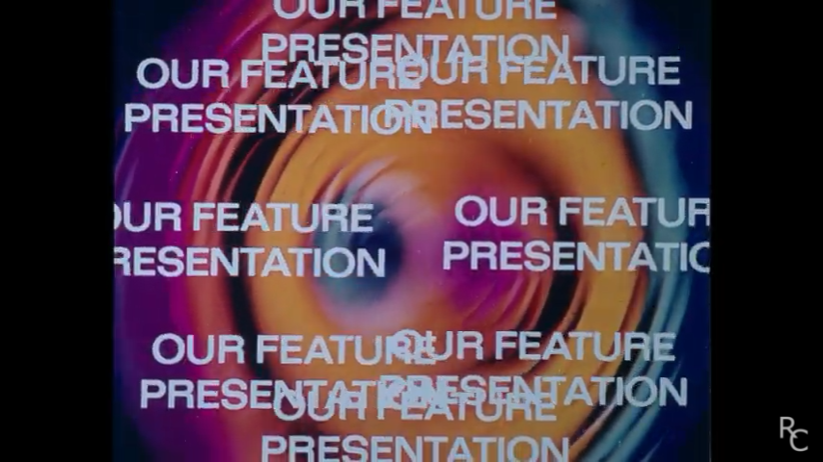
Oh. And here are a few more, some of which I have never seen before:
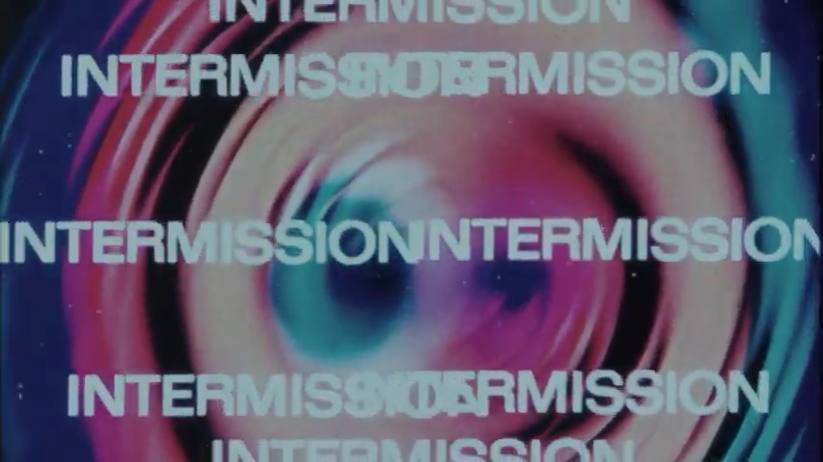
These things always made me wonder: Who designed them? How were those swirling colors achieved? Where were these made? Who were on the crew? Who composed the music? Who played and recorded the music? What were they paid? Oh, as I write these things, I make discoveries. The music is adapted (by whom?) from “Soul Thing” by The Keith Mansfield Orchestra. I learn more. These were referred to as
• The Sorrow and the Pity, 13–19 April 1973: Mr. Master and, later, separately, Mr. Riot Act,
both mused that, “The Sorrow and the Pity, that was the condition of the print!”
They said that they spent literally days repairing that film.
They couldn’t request a replacement, because it was the only print of the film in the country.
• Helpmates and Sons of the Desert, 18 August 1973:
My sister and I attended.
Maybe 15 or 20 others in the auditorium, and Mrs. A was at the candy stand.
Some good laughs.
Helpmates was at the tail end of the L&H golden run.
Most of their feature-length flicks are quite weak, but Sons of the Desert is one of the few that’s worth seeing.
I couldn’t understand why they were cropped.
This was the first time I noticed the flyers, and so I signed up to get onto the mailing list.
• A Tale of Two Cities and David Copperfield, 12 October 1973:
Maybe the usual 30 or 40 people attended.
As soon as Fields appeared on screen, pretty much everyone guffawed.
Fields was a hero to the hippies and I thought he was wonderful.
He would not be a hero to many people now, and I no longer think he’s wonderful.
He did some good stuff, yeah, but I no longer find him appealing.
Nothing really to report about these presentations on this evening.
I couldn’t understand why they were cropped.
I loved those two movies so much.
Well, I was 13. That’s my excuse.
By the time I was 18 or 19, I found them unendurable, braindead travesties of the novels from which they were adapted.
• Citizen Kane, 16 June 1975. I misremembered this as 1974. Oh well.
Great movie. Totally stunning. I didn’t understand until years later that this was a raucous comedy.
Horribly cropped to 1:1.66.
Only a handful of people in the auditorium.
I remember that Mrs. A was at the candy stand.
• Wednesday, 6 August 1975: The morning Albuquerque Journal included a PG rating in the ad for O Lucky Man!
That surprised me, and so I called Movie, Inc., to confirm that the rating was correct.
The young gal who took my call looked up the movie (I’m sure she just opened the newspaper to check the ad),
and told me that the film was rated PG.
Well, that was my semi-reluctant introduction to R-rated movies, and I’ve never looked back.
I am eternally grateful to that typographical error.
• The Mouse That Roared, 15–16 July 1975: It was 16mm, run on Don Pancho’s awful Bell & Howell Filmoarc modified for xenon.
• Dr. Strangelove, 19 July 1975. First time I saw the movie.
I was almost alone in the auditorium, and without a crowd, it’s just not a laff riot.
Great movie, though. No major issues.
• Dark Passage, 12–18 September 1975: The exchange mistakenly sent over Dark Victory instead.
• if...., 21–22 November 1975: It was the R version, matted in the lab to 1:1.75.
Different prints are different. Some are open-matte 1:1.375, and others are X.
• Glen and Randa, 21–27 November 1975: It was a handmade print.
Every shot was physically spliced in.
I mused that it must be a rotten movie if the print was hammered together so cheaply,
but Mark Brown, who was projecting that Saturday afternoon, assured me that it was actually quite a good movie.
• A Session with The Committee, 19–20 December 1975:
It was five reels, but the leaders on the film, which were original and printed by the lab, with the title and reel number neatly typeset,
gave the reels as 1, 2, 3, 4, 6. There was no reel 5.
Whether that was an error in labeling or whether reel 5 really was missing, I never found out.
Ernie assured me that, on screen, there was no obvious evidence of anything missing,
but since it was a sketch comedy, it was really impossible to know for sure.
Ernie told me that the audience were rolling in the aisles all the way through.
• Bugs Bunny Superstar, 9 April – 13 May 1976:
The 1:1.66 cropping was egregious, but literally nobody could tell the difference (except for me, and I was writhing in agony).
• The General and Sherlock Jr., 9–11 April 1976:
They were created by Bill Scott of Jay Ward Productions, and Rohauer got a presentation credit.
The General was optically reduced to Academy 1:1.375, but The Guild, of course,
cropped it to utter senselessness at undercut 1:1.66.
Parts were literally incomprehensible, and the result was completely devoid of laughter.
It was Jay Ward’s notorious
“sound version,”
with little music, but with sound effects, and with
captions rather than proper titles.
This was first issued in 1970 (not 1953, not 1954, no matter what anybody says), and the changes diminish the film terribly.
Because of the captions at the bottom of the image, the projectionists at The Guild reframed the image to show only the bottom,
which was rather a loss, because some of the most important action occurred only at the very top of the frame.
(Somewhere in my storage locker I have a VHS of this edition of the movie, courtesy of Chuck Van Dusen, a Buffalo booking agent,
who recorded it off of Showtime and ran off a second copy for me. I didn’t want it because I liked it —
which I sure didn’t! — rather, I wanted it only for the record.)
Sherlock Jr. was the usual two-and-a-half-reel edition,
about 44 minutes, optically reduced to Academy 1:1.375, but also reframed, cropped, futzed with, and so forth,
because modern lab folks dislike undersized frames, which were quite common in the silent days.
This was issued probably in early 1972, and the score was
the jazz compilation selected by Bill Scott,
which, I thought, fit wonderfully.
I don’t think it had the shot in the billiard scene of the cue ball magically jumping over the 13 ball,
though I saw that amazing stunt later on in what appeared otherwise to be an identical print
(I think at Jackman Hall at the Art Gallery of Ontario in Toronto in 1995).
Some Ward/Rohauer prints have that gag and some Ward/Rohauer prints don’t, and I still can’t figure out how it was done.
It was not a camera trick and it was not behind-the-scenes machinery.
Buster somehow figured out how to hit the ball with just the right spin that it would perform that odd magic trick.
Because so much vitally important visual information was missing at 1:1.66, the result was absolutely humorless.
The projectionists would run one reel showing only the bottom of the image, and the next reel showing only the top of the image.
I mean, you couldn’t see what Buster was sweeping.
When he was running on top of the train, he was entirely cropped off.
The whole point of every scene was lost.
That was my introduction to that movie.
Nonetheless, I watched these movies, I think, four times each.
Because I knew The General from Killiam’s 16mm version,
and because I knew Sherlock Jr. from written descriptions,
I could follow both, even when 100% of the action was entirely cropped off.
I could easily determine that, once upon a time, both these movies were quite good and quite funny.
Nobody else in the small audience picked up on any of that.
And when I say small audience, I mean, like, hey, three people.
It was Deadsville, really.
• The Loved One, 17 July 1976: Reasonable print, no major issues.
Interesting movie, included much that was not in the book.
• Barry Lyndon, 1–7 October 1976: The print was nearly pristine.
This was the only time I watched the movie all the way through, because it was properly presented at 1:1.66.
• A Clockwork Orange, 8–14 October 1976: The first time I saw this movie.
The print was almost pristine.
It had an R tag printed in, but I’m pretty sure it was the X version, as it contained a little gag during the speeded motion
that I never saw at another cinema.
It was fresh from the lab, and it is the only time I ever saw an edition of the movie with intense saturation
that exactly matched the original lobby cards.
There was a single jump in the action, in the milkbar, after Alex smashes Dim with his cane.
As Dim slowly sits up again, there is a jump of maybe eight or nine frames.
Why? Well, Mark Brown told me.
The first night of the movie, he forgot to latch the 6,000' feed reel to the projector # 1.
He happened to look up just as he saw the reel begin to fall down.
So a tiny bit of film was damaged and had to be removed.
• All Screwed Up, 15 October 1976:
I didn’t see it, but, out of a sense of adventure that I would never repeat if my life depended on it,
I talked Ernie and Jamie into descending the staircase and watching the automatic change-over from the auditorium.
For a second they were hesitant, but then they agreed.
Perfect change-over , except, of course, for the usual static sounds.
Jamie was saying Wow over and over again as he was watching the motorcyclist during that moment.
• Distant Thunder, 22 October 1976. Good movie, but I hardly remember it.
Uneventful presentation. No comments to make.
• Face to Face, 29 October 1976. Again, an uneventful presentation.
I liked the movie when I was 16.
It would drive me bonkers now.
• A Labor of Love, 21 January 1977. I walked in for a few minutes just to say Hi to Mrs. A.
I snuck a peek at the movie, 30 seconds at the most. It looked awful.
• Idi Amin Dada: Self-Portrait, 4 February 1977. Uneventful presentation. Terrifying movie.
• F for Fake, 11 March 1977:
I dropped by for five minutes and to this day I regret not having stayed for the movie.
I was probably too busy with homework.
• It had to have been on 26 March 1977, or maybe the Saturday before or after, but I think it was 26 March,
that I dropped by The Guild, maybe to say Hi to Mark Brown,
maybe to say Hi to Mrs. A.
It had to have been on one of those three Saturdays that I entered the auditorium just to watch the previews of coming attractions,
and that must have been when I saw the preview for The Rocky Horror Picture Show,
and the preview made it look like a piece of junk.
Little did I realize that the movie itself is glorious.
• Ben-Hur, 24 April 1977.
I wasn’t there, but I saw the aftermath.
The print was 4tr/mag-op with CS Foxholes.
Nobody at Don Pancho’s had seen or known about such a thing before,
and so spliced it together with the Hollywood Film Company machine, which has only Academy sprocket teeth,
and thus damaged every bit of film that needed splicing.
Thank heaven that the projectors had CS sprocket teeth!
• The Wizard of Oz and Meet Me in St. Louis, 30 April 1977. Mark Brown was projecting the Saturday matinée,
and he repeatedly referred to the movie as Meet Me in St. Louis Louis
to someone (a child and her mother?) who were also in the booth at the time.
“Did you like Meet Me in St. Louis Louis?”
Maybe this was the day when I saw Wizard, but I don’t think I stayed for either movie.
I was just passing by and walked in to say Hi to Mark.
• Performance and O Lucky Man!, 14 May 1977.
I finally go to see them, all the way through, in an auditorium. Wow. Great movies.
Performance was the X version with Johnny Shannon’s real voice.
It was “ketchup” this time, not “claret.”
• The Way He Was, 21 May 1977. Mr. RRE was in the booth,
and he said he had to enhance a cue mark, because the lab cue was not the full four frames, but only two frames,
separated by a cueless frame, that the cue was only a half-circle,
and that it popped on as there was an animated spinning spiral taking up the entire screen.
I climbed down to chat for a few minutes with Mrs. A, and I witnessed an elderly couple painfully enter the lobby.
The guy asked, “It’s not R-rated, is it?”
Upon being assured that it was not, Mrs. A sold him a ticket.
They seemed nice enough, but barely functional.
Out of curiosity, I followed them.
As they made their way into the dark auditorium, they were having trouble.
The curtain was open, and the screen was plainly visible.
Said the wife to her husband, “Which way is the screen?”
Well, it’ll happen to me too, unless I’m assassinated.
I stayed to watch a few minutes of the movie, and it was gawdawful.
It is now available on video under a different title, White House Madness.
• It must have been on 6 or 7 July 1977 when a friend and I attended The 400 Blows at Don Pancho̵s.
He must have driven me there.
Then my memory gets terribly confused.
The only reconstruction I can make is that he left after the first movie,
but that I stayed on, by myself, to see Two English Girls. I knew this would be trouble.
The buses didn’t run that late. Fortunately, I had the $5 or so to pay for a cab, which is what I did.
Rarely did I have so much money.
• Yellow Submarine and Fantastic Planet.
It must have been on 9 July 1977 when I saw Yellow Submarine, together with a friend.
That’s when I was horrified by that terribly placed change-over.
This was probably when I attempted to watch Fantastic Planet but walked out after maybe 15 minutes.
What a bore.
• Fellini’s Casanova, 16 July 1977.
I sort of wanted to see this, but didn’t, for some reason.
Mark Brown was in the booth, and he remarked that,
“The message of the movie is either that Casanova f***ed like an automaton, or that we all f*** like automata.”
Then I felt really stupid, because I didn’t know what an automaton was.
He explained it to me.
I was really surprised, because he was running the film at 1:1.66 and it filled the screen.
Italian movies are usually hard-matted in the camera at 1:1.85.
Actually, he told me, most of it was 1:1.375 on the print, but a few shots here and there were 1:1.85, with black bars on the top and bottom.
He said he was thinking about switching to 1:1.85 for future shows.
He showed me the shipping bands: “MINIMUM ASPECT RATIO 1.37:1. MAXIMUM ASPECT RATIO 2.00:1. PREFERRED ASPECT RATIO 1.85:1.”
That was the first time I had seen such a message on a shipping band.
Oddly, prints that have circulated since were all matted in the lab at 1:1.85. Too bad.
He was most amused (or maybe most unamused, I couldn’t tell)
by the scenes with black plastic substituting for the Mediterranean Ocean, and I got to see one such moment.
• Metropolis and M, 21 July 1977.
I dragged my mother along, though I shouldn’t have.
She doesn’t care for stuff like this.
I knew that, after all, because I had seen Metropolis already.
On PBS.
Rather, I thought I had seen this movie already.
What Donald Pancho’s showed was not at all what PBS had broadcast,
and neither is even remotely similar to any version available since that time.
The version shown at Donald Pancho’s, like the version shown on PBS,
has been disappeared, and chances that you will ever see it are about nil.
The story gets massively confusing, and I spent the better part of a year trying to make sense of what had happened.
If you are interested in that epic story,
click here.
• Little Big Man, 30 July 1977.
I was reading the book, for fun, and was nearly at the end.
So I decided I should see the movie.
Some friends went with me, and my heart sank.
Everything that was brilliant in the book was totally mucked up in the movie and turned into a stupid contrivance.
There was a gap in the movie, but I don’t remember where. Apparently a huge chunk of footage was missing.
I was so stupefied by what I was watching that I didn’t even notice the gap.
My friends had to explain to me where it was.
They didn’t agree with me when I said that the movie was a piece of garbage.
One of them right afterwards read the book, and he then said to me, “You were right!”
Again, it was Arthur Penn.
Again, it started off well, but quickly tanked, as he had clearly lost all interest in the project,
which would explain why he totally ruined the script.
I didn’t stay for the second feature.
• The Gold Rush, The Music Box, Pool Sharks, The Golf Specialist, The Dentist,
The Fatal Glass of Beer, The Pharmacist, The Barber Shop, 31 July 1977. I saw this program twice,
the second time with my mother. Lonnie ran it the first time. The second time, Lonnie was in the lobby,
but Ernie was running the films. Lonnie didn’t know what the Fields program was, and so I explained it to him.
Just at the moment, the phone rang, which was good timing, because the caller asked what the Fields program was, and Lonnie could explain it to him,
no prob. The Gold Rush was the Killiam print, cropped horribly. Since part of The Music Box was incomprehensible the first time,
I told Ernie to frame all the way to the top of the image when we see the hat thrown down the hill.
“Shouldn’t we frame all the way to the bottom?”
“The camera is on top of the hill, and so when the hat falls, it falls to the top of the screen.”
He took heed, and he reframed so we could see a truck run over the hat as soon as it lands at the bottom of the hill.
In the previous showing, that had been entirely cropped off. It did not get a laugh the first time.
It got a laugh the second time.
The Fields shorts were from Rohauer, and Pool Sharks was missing the left side to make way for the music track.
The main title was changed: “W.C. Fields as THE POOL SHARK in his first film, ‘Pool Sharks’.” The gags were entirely lost off the bottom of the screen throughout
the entire golf game in The Golf Specialist. Ernie thought that the closing gag in The Barber Shop was
about the funniest thing he had ever seen in his life.
• Black Orpheus and Beauty and the Beast, 6 August 1977: Loved ’m both. Great stuff.
Beauty and the Beast, surprisingly, more or less survived the 1:1.66 crop,
though the candle sconces on the walls were largely missing. Oy.
When I ran Black Orpheus at another cinema a few decades later, I was surprised and disappointed that the subtitles
were misprinted right at the bottom of the frame. I had to run it at 1:1.375 even though it was nicely composed for a 1:1.66 crop.
The same problem is also, I think, on the Criterion DVD.
It still looks marvelous at 1:1.375, but there is too much room at the top and bottom.
• Black Moon, 25 August 1977: I was visiting a friend and mentioned that
Black Moon sounded interesting and that maybe we should go see it.
He was not convinced, and said it sounded terrible.
“No, I think it sounds interesting.”
Then we got to chit-chatting over the kitchen table, and suddenly he looked at me with an adventurous smile and
said, “Now that I think about it, let̵s go see Black Moon!”
So we hopped into his car and off we went.
Terribly tedious movie, but fascinating, nonetheless.
We were both puzzled by the beginning, because we had never seen such an animal.
After the show, I sauntered up the spiral staircase to see Lonnie (I think it was Lonnie that night) and I asked him,
“What was that animal at the beginning?”
“A badger,” he responded nonchalantly.
“Really? I’ve never seen one before.”
“That’s because you city folks don’t know anything about wildlife.”
• Alice’s Restaurant, 14 or 15 September 1977:
My friend drove me over to see this one, too, since neither of us had seen it.
It was quite obviously the PG version, not the original R.
I knew that because of frame blowups in Show magazine.
Good movie, yes, but it just didn’t quite jell.
Something about Arthur Penn.
He starts off nicely and then just seems to lose interest.
I don’t think movies are in his heart of hearts.
• Jabberwocky and The Magic Christian, 3 December 1977.
Saw these. Never laughed at Jabberwocky.
Laughed until I was in pain at The Magic Christian.
My opinions have nearly flip-flopped through the years.
No serious incidents with the presentations.
Ernie was running the booth that afternoon.
• Women in Love, 11 December 1977.
I remember seeing this on a Saturday, but nope, it was a Sunday.
A friend drove me over.
No exceptional incidents with the presentation.
• Allegro non troppo, 17 December 1977. A friend drove me over and we had some great laughs with this movie.
Ernie was in the booth, and after the show not only did I visit the booth,
but so did one of his friends, a music buff, who said that Prisney had done it better.
• A Night at the Opera and A Day at the Races, 14 January 1978.
Horribly cropped to 1:1.66.
Horrible movies.
I love the Marx Brothers, but not these two flicks.
• West Side Story, 21 January 1978.
Corny but nice, with great dancing.
I stayed to see the opening credits again, but there weren’t any.
For the second show, Ernie shut off the picture until the overture was over.
After all, he had seen a bit of it at the first show that afternoon, and it was just random colors,
which he thought was not meant to be seen.
He thought it was just entrance music that should not be on screen.
I had to explain to him that, no, it should be seen.
He seemed a bit grateful that I let him know.
• Wings, 22 January 1978.
Odd for me to attend on a Sunday, but this was a silent movie, and I was crazy about silent movies.
Of course, it was a full-aperture Silent print, and Ernie had never seen such a thing before.
He wondered if it should be marked “1.33,” and I had to explain to him that
Silent 1.33 and Sound 1.33 are two entirely different things.
Everything on the frame of a silent movie needs to reach the screen.
Of course, it didn’t.
Hardly any of it reached the 1:1.66 screen.
Since it was a full-aperture print, there was, of course, no music.
Just dead silence, like when I had seen that 16mm print of The General a few years before.
It was the usual Paramount repertory print, entirely black and white,
with the stenciled flames and fires reproduced in cartoony black and white.
So I watched it, in dead silence, apart from the distant muffled sounds emanating from the booth,
mixed together with sounds of shoes sliding on the floor and the occasional throat clearing.
The cornball story is purest soap.
The acting was dreadful.
Nonetheless, it’s a great movie.
After the show, a bunch of kids from Sandia HS entered, and I told them rather excitedly about Wings,
but it was in one ear and out the other. They were there to watch Stalag 17,
which was the school play they were currently rehearsing.
For the record, I am completely convinced that the filmmakers designed Wings to be projected at 80'/min,
but it was never shown that way, because Paramount decided to add synchronized music and effects on disc,
which necessitated 90'/min, which, by 1927, was the most common speed at cinemas, anyway.
When I ran it some decades later, I chose 74'/min, which worked nicely, but I wouldn’t slow it down quite that much again.
I’m pretty sure that the print I ran in 1990 or thereabouts was the same print that Don Pancho’s had run in 1978.
Betcha.
• Everything You Always Wanted to Know about Sex and Sleeper. 28 January 1978.
A friend drove me over. Hilarious.
Ernie made a mistake during Sleeper.
He was out of frame for a reel, and when he tried to turn the knob, he couldn’t,
because it was already turned all the way.
Surprising. When you need to frame up or down, after the end of the reel you should always set the framing knob back to the center.
Either he forgot or didn’t know.
So, for an entire reel, we saw the top of the image, filled everywhere, all the time,
with barn doors, lights, sun screens, cables, microphones.
The action in the middle of the image was largely cropped off.
I was fascinated to see all the stuff outside the safe area.
My buddy was annoyed no end.
• Tom Jones and Joseph Andrews, 26 February 1978.
The print of Tom Jones was almost pristine, with dazzling colors.
At the time, I rather enjoyed it, though it was no match for the book, which was a great book.
If I were to be confronted with this movie now, I would not enjoy a frame of it.
Totally, horridly putrid and offensive.
Joseph Andrews was a good book but an infantile movie, disgraceful, though I was thrilled that Jim Dale was in it,
portraying an Englishman with an American accent.
Jamie was on duty that day. I mentioned to him how much I liked Tom Jones,
and he responded, simply, “Really? I liked Joseph Andrews.”
• The Harder They Come and Black Orpheus, 4 March 1978.
That was my first time watching The Harder They Come, which was an okay print but with shattered reel ends.
I must have seen Black Orpheus again that afternoon, though I have no memory of doing so.
• The General and Safety Last, 26 March 1978.
I could not attend, because dear old daddy, only because he knew I had just been hired,
decided to take us on vacation.
My very first shift was scheduled to be 25 March 1978, but I had to put in for a vacation request.
On my very first day at my new job.
That’s what dear old daddies like to do to their kids, I guess.
I was certain that would get me fired, but it didn’t.
So I was not around to see these, but I knew the show would be a disaster.
The General was a full-aperture Silent print from Killiam, and so Ernie ran it dead silent.
Again, even though he had already run Wings, and even though I had explained to him what the Silent format was all about,
he got confused again.
When I started working on 1 April 1978, I noticed that in his inspection report he put down the format as “1.33?” with a question mark.
Again, I explained to him what the Silent format was all about,
and that Silent 1.33 is different from Sound 1.33.
I typed up an index card with all the standard apertures, including Silent and 1:1.18, and Ernie seemed grateful
and posted it at the inspection bench.
Safety Last was the abridgment from Time Life, squashed together with excerpts from Hot Water,
optically reduced to a tiny square in the middle of what would have been a 1:1.85 frame.
I had seen that print already at the Sunshine,
and the projectionist, Bob Manke, Sr., told me that it was printed that way because it was printed without enlargement from a 16mm submaster.
Nope. Nope. Nope. He should have known better than that.
• Hans Conrad Fischer’s three educational films, The Life of Ludwig van Beethoven,
The Life of Anton Bruckner, and
The Life of Mozart, April 1978, were all 1:1.375, and our 1:1.66 crop was totally dreadful in every way,
and there was nothing I could do about it.
And not one single person complained.
As I go through these listings and riffle through my memories, it occurs to me:
The owners, managers, and bookers who selected these films, well, they never watched these films.
They couldn’t have cared less.
They were plugged in to the system, and so they knew which movies had reliable audiences at the time,
and so they kept on booking them over and over and over.
If a movie failed, they didn’t bother to bring it back.
It never occurred to them that they were running the movies incorrectly, which was the reason for many of the failures,
it never occurred to them that silent movies cannot be presented the same way as sound movies,
it never occurred to them that what the audiences loved a thousand times more than the movies themselves
was the experience of being in a crowd of serious movie lovers.
That was a warm, tingly feeling that is totally addictive.
The owners and managers never understood what they had in their hands.
They could have created a artistic-social movement, a new community,
they could have led a massive change and become champions of the whole city.
Instead, they ran the business as nothing other than a business, and so they totally fumbled it,
which is why they lost the business in less than 20 years.

